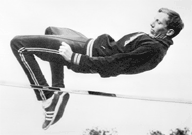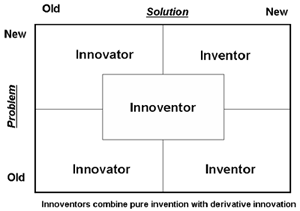 Not all flops are failures. Take Dick Fosbury’s for instance. He began experimenting with alternative, unconventional methods of high jumping as a high school sophomore. Rejecting the straddling approach, which had been the standard for the prior forty years, Dick tweaked the old-fashioned scissor kick, eventually morphing it into a new and unique approach, which was eventually dubbed the “Fosbury Flop.”
Not all flops are failures. Take Dick Fosbury’s for instance. He began experimenting with alternative, unconventional methods of high jumping as a high school sophomore. Rejecting the straddling approach, which had been the standard for the prior forty years, Dick tweaked the old-fashioned scissor kick, eventually morphing it into a new and unique approach, which was eventually dubbed the “Fosbury Flop.”
The track and field community initially scorned Fosbury’s approach, labeling it “unsafe” and “too unorthodox” for the average jumper to master. However, nothing sells an innovative idea like winning. After Fosbury set an Olympic record at the 1968 Mexico City games, jumping 7 feet 4.25 inches, track coaches all over the world took notice.
The adoption of the Fosbury Flop was rapid. The last high jumper to set a world record using the straddling approach was Vladimir Yashchenko in 1977. As shown in the chart below The Fosbury Flop had become the international standard by the 1980 Olympics.
| Olympic Year | Floppers | Straddlers |
| 1968 – all competitors | 1 | Everyone else |
| 1972 – all competitors | 28 | 12 |
| 1980 – finalists | 13 | 3 |
| 1984 – finalists | Everyone | 0 |
Flop Innovations
In general terms, inventors often rely on new solutions, while innovators prefer working with existing solutions. However, problems and solutions are often not purely “new” or “old.” In many cases, a portion of a solution is “new,” and a component of the problem is “old.” Inventors vs. Innovators describes some of the general personality traits associated with entrepreneurial problem-solving styles. However, in reality, competitive advantages often result from a combination of invention and innovation.
Harvard Professor Michael Porter notes in his article, “What Is Strategy?”, that entrepreneurs should strive to create a sustainable competitive advantage by “…performing different activities from rivals’ or performing similar activities in different ways” (italics from original text). This is in contrast to the approach taken by most Big Dumb Companies (BDCs), which often focuses on performing the same activities as their rivals, only better.
Such innovations represent an opportunity to create a sustainable advantage, at least in the near-term, by changing the rules of the game and executing a pre-existing activity in a new way. As noted in Two Brothers, startups can out-maneuver BDCs by changing the key parameters upon which competition has historically been based. Rather than trying to do the same things better than their competitors, savvy entrepreneurs identify new, value-adding methods to better serve customers. They innovent new ways to create and deliver value to their customers, and this often results in a sustainable competitive advantage.
 The association of innovators and inventors and their respective reliance on new and old problems and solutions is shown in the accompanying chart. Not surprisingly, most entrepreneurs fall somewhere in the middle of the somewhat academic “Innovator” and Inventor” distinctions, acting as Innoventors who address old and new problems in a flexible, non-dogmatic manner.
The association of innovators and inventors and their respective reliance on new and old problems and solutions is shown in the accompanying chart. Not surprisingly, most entrepreneurs fall somewhere in the middle of the somewhat academic “Innovator” and Inventor” distinctions, acting as Innoventors who address old and new problems in a flexible, non-dogmatic manner.
An Innoventor approach currently being deployed by RingRevenue. They recently entered the mature Affiliate Marketing world, which comprises hundreds of networks, thousands of advertisers and tens of thousands of online publishers. There has not been a significant innovation in the affiliate market since the unfortunate advent of the pop-up ad.
A significant problem in the Affiliate Marketing world is the leakage, which results when a publisher alerts a potential customer to an advertiser’s offer and the customer picks up the phone to contact the advertiser, rather than following a click path to purchase. In such instances, the publisher receives no remuneration for leading the customer to the advertiser.
Although advertisers always appreciate incremental sales, they ideally prefer to track the effectiveness of their advertising efforts. When leakage occurs, it is impossible for the advertiser to determine the source of any particular call.
RingRevenue’s approach to eliminate leakage is relatively simple, yet effective. Central to its platform are unique phone numbers issued to publishers for use in both online and offline ads. RingRevenue tracks calls placed to these numbers, which allows advertisers to enhance the effectiveness of their ad spends by compensating publishers for generating high-quality calls and/or outright sales. Most importantly, no changes need be made to the advertiser's call center nor does the caller’s behavior need to be modified.
RingRevenue’s platform integrates with existing affiliate networks, such as Commission Junction, PepperJam and LinkShare. With RingRevenue, affiliate networks can address leakage while enabling advertisers to increase their sales, strengthen their consumers’ loyalty and improve the efficiency of their ad spending.
RingRevenue is an effective Innoventor, as it solved an “old” problem via a clever combination of new and existing technology. It has addressed the long-standing leakage problem by seamlessly integrating its sophisticated VoIP softswitch “invention” with the existing telephony system, affiliate networks and users’ traditional buying behaviors.
The Berkoff Blastoff
Fosbury is not alone in his role as an innovative, transformative force in the world of sports. Although you may not know his name, David Berkoff revolutionized the world of swimming by refining a technique whose origins date back to the 1920s – the dolphin kick.
 In the late 1980s, Berkoff began consistently winning races by dolphin-kicking underwater at the start of each race and after each flip turn, for as much as 35 meters at a time. Berkoff quickly went from being a mediocre swimmer to a world-class champion, winning four Olympic medals in 1988. Not surprisingly, given the media’s love of alliteration, his technique was termed the “Berkoff Blastoff.”
In the late 1980s, Berkoff began consistently winning races by dolphin-kicking underwater at the start of each race and after each flip turn, for as much as 35 meters at a time. Berkoff quickly went from being a mediocre swimmer to a world-class champion, winning four Olympic medals in 1988. Not surprisingly, given the media’s love of alliteration, his technique was termed the “Berkoff Blastoff.”
Looking back on the impact of the “Blastoff” on his career, Berkoff confessed, “I probably wouldn't have made the Olympic team [without it]. I probably would have been a good backstroker but not a great one. It was something that really kind of changed the way backstroke was swum.”
Berkoff’s initial impact was limited to his event, the backstroke. However, other competitors soon began utilizing his technique, which caused International Amateur Swimming Federation officials to institute a new rule precluding underwater swimming beyond 10 meters from the pool walls (which was later relaxed to 15 meters). The official reason given for this rule change was “the safety of the athletes.”
However, most fans of competitive swimming agree that the real reason for the ruling was the officials’ concern that the dolphin kick would migrate from backstrokers to include freestyle and butterfly swimmers. Thus, an otherwise non-competitive swimmer could conceivably defeat world-class champions by dolphin kicking the majority of the pool’s length. They feared swimming would become a largely underwater affair, which would diminish the differentiation between the various strokes.
Even with the significant limitations imposed upon it, the Berkoff Blast has significantly impacted the world of competitive swimming. A number of experts cite Michael Phelps’s ability to exploit the dolphin kick as a differentiating factor that contributed to his garnering eight gold medals at the Beijing Olympics.
According to Dr. Rajat Mittal, who applied his understanding of fluid mechanics to the world of competitive swimming, “…almost 90 percent of all the thrust, the propulsion for the swimmers, is coming from the part of the foot beyond the ankle." Mr. Phelps enjoys a size 14-shoe. In addition, the fact that he can hyper-extend his ankle beyond that of most ballerinas does not hurt his performance either.
Obvious Works
“You miss 100% of the shots you never take.”
Wayne Gretzky, Hall of Fame hockey player
In both instances, Fosbury and Berkoff came upon their innoventions while engaging in their sport. They did not study the art of jumping or swimming in an attempt to create ideal methodologies. Rather, they both sought a better way and focused their efforts on competing in a new manner, on the playing field, not on the sidelines. As noted in Pressure, your ability to devise innoventions increases exponentially once you enter the market and are forced to fight for your adVenture’s survival.
For Fosbury, "It was not by design at all. It was just simply intuition. It was not based on science or analysis or thought or design. It was all by instinct. It happened one day at a competition. My mind was driving my body to work out the best way to get over the bar."
As Berkoff notes, "It seemed pretty obvious to me that kicking underwater seemed to be a lot faster than swimming on the surface." The key to his success was that he did not rely on the then-standard flipper kick when he tested his underwater theory. Similar to Fosbury’s initial adoption of the antiquated scissor approach, Berkoff reverted to a kick that had been attempted and subsequently abandoned by competitive swimmers nearly 90 years earlier.
Forty and twenty years later, respectively, the Fosbury Flop and the Berkoff Blast remain the standards of their sport. However, there are undoubtedly innoventor high school athletes who are attempting to Reinvent The Wheel and devise their own competitive advantages by changing the rules of the game. Let the games begin.
Full Disclosure: As of the writing of this article, I have no financial interest in RingRevenue. However, in my role as a Venture Partner at Rincon Venture Partners, I am currently evaluating a potential investment. To determine my current involvement in RingRevenue, if any, review Rincon Venture Partners’ Portfolio.
p align="center">— Get hands-on advice from your John Greathouse, Subscribe Today. —
Copyright © 2007-9 by J. Meredith Publishing. All rights reserved.




Pingback: Knowtu » links for 2009-01-14
Pingback: Everyday elements are the building blocks of innovation | Recessioneering
Pingback: What is an Innoventor? « Think Outside the Box, My Friends